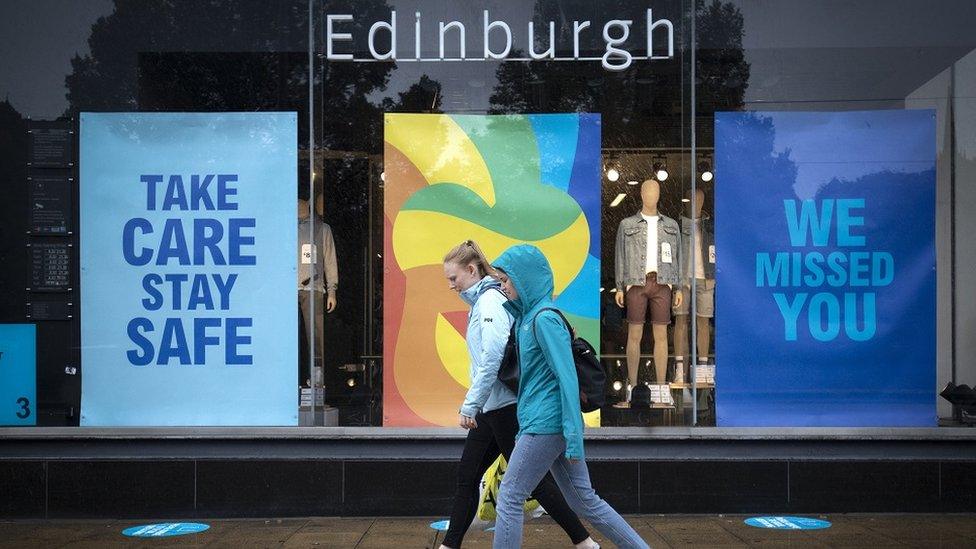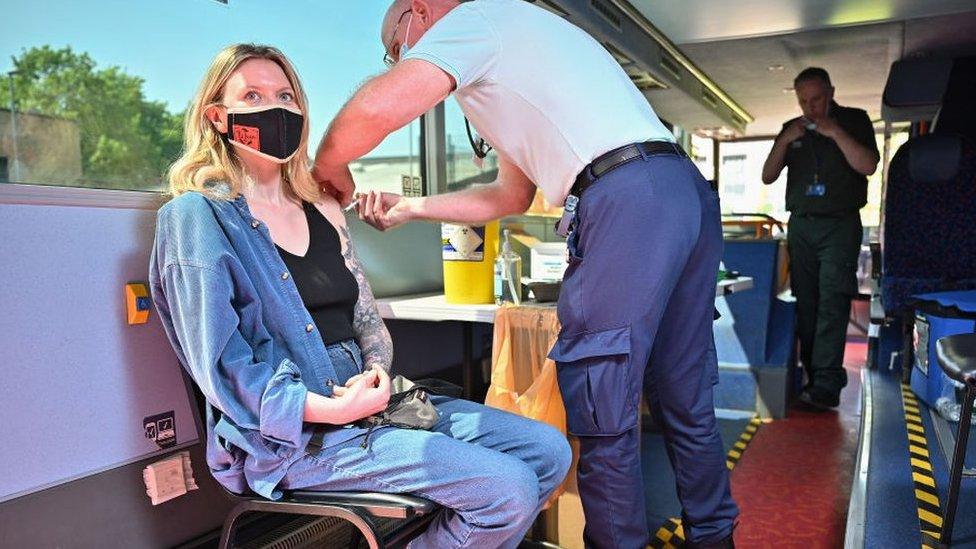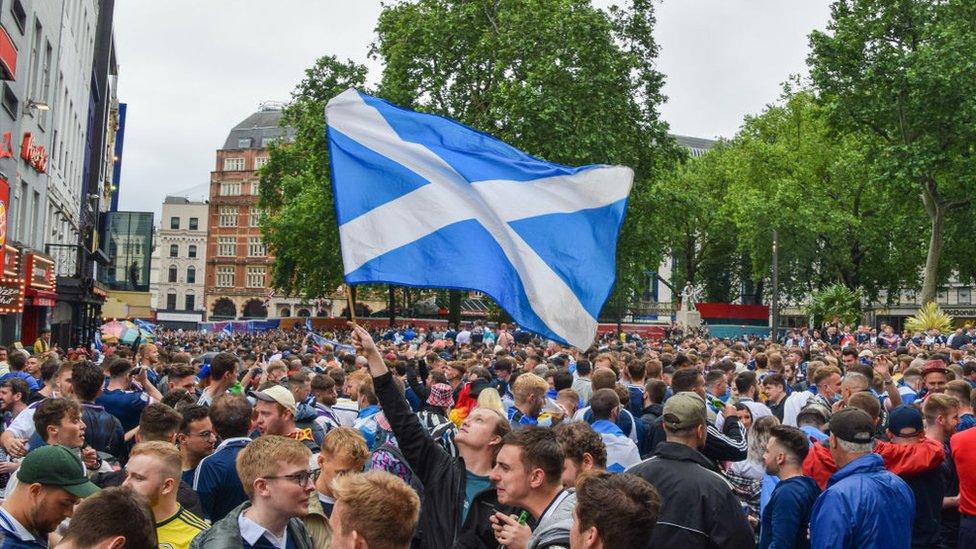Covid in Scotland: Can rising Edinburgh cases be explained?
- Published

Edinburgh has seen positive coronavirus cases reach unprecedented levels in the last two weeks.
The most recent surge in Scotland's capital saw the weekly rate jump to 582 cases per 100,000 people - that shatters the previous high of 242 reached in January.
So why now, and why Edinburgh?
Have the Euros, tourism and opening up of hospitality combined to create a perfect environment for the new Delta variant to thrive?

Vaccination rates
Research has shown that even one dose of the vaccine significantly reduces the risk of infection across all age groups.
In Scotland, public health officials are increasingly confident that the immunisation programme is relieving the front line pressure on the NHS.
But Edinburgh currently has the lowest vaccination rate out of the country's 32 council areas.
Latest figures suggest 76.1% of the city's population over 18 have had their first dose, with 48.7% having received their second. The majority of these people are in the 18-49 range.
By comparison the first and second dose rates in Glasgow are slightly higher at 76.8% and 49.3% respectively.
The council areas with the best vaccination rates are those with smaller rural populations such as Shetland Islands, Western Isles and Orkney Islands.

A government spokeswoman said "a number of steps" had been taken to accelerate the vaccination programme "in the local authorities of NHS Lothian".
She added that NHS Lothian would be increasing over-18s drop-in appointments from 29 June.
But Linda Bauld, professor of public health at the University of Edinburgh, said this was likely a "minor factor" in the recent surge in Edinburgh cases.
"All the urban areas have been the slowest in terms of delivering the vaccines," she said. "Edinburgh is not unique in that - it's consistently been Glasgow, Aberdeen, or Edinburgh".
This is simply down to the fact that it is more complex to deliver vaccines in a large urban area.
Prof Bauld added that lower vaccination rates at this stage in urban hubs was largely down to cities having a typically younger population compared to somewhere like the Scottish Borders.
Easing of restrictions
Edinburgh, like many of the council areas across Scotland, moved to level two on 17 May.
This easing of restrictions meant travel was now permitted, up to six people from three households could meet inside and stay overnight, and shops and leisure attractions could now open.
But Public Health Scotland (PHS) figures suggest this easing cannot be linked to the current increase with no immediate rise in positive cases in the weeks following.
This conclusion appears to be backed up by "community mobility" reports from Google.

This publicly available information is based on location data that the tech firm harvests from people's smartphones.
The most recent Edinburgh-specific report, external suggests that footfall to restaurants and shops in June remained 31% below baseline figures.
Google's data also indicates that by late June many people continued to work from home, and that the use of public transport remained low.
However, the reports from the tech giant are limited in scope as they only capture the movements of people who have explicitly turned on the location history setting in their Google account.
While not Edinburgh-specific, Public Health Scotland data shows that shopping and eating out account for the majority of the places visited by people in Scotland the week before their positive test.

Sporting events
Before Euro 2020 kicked off earlier this month there were concerns that restriction fatigue and large gatherings of people watching Scotland's fixtures could see an increase in positive tests.
On Wednesday, a new PHS report, external confirmed that two thirds of 1,991 cases were of people who had travelled to London for Scotland's game with England on 18 June.

Nearly 400 of the 2,600 Scotland fans inside Wembley later tested positive for the virus
These tagged cases related not only to matches at Hampden or Wembley, but also to informal gatherings at pubs and private homes.
Essentially, these were settings where the more transmissible Delta variant could thrive.
The data reveals that the majority of the specimen dates were marked 21-22 June - dates which also coincided with the surge in positive cases in Edinburgh.

However, the report does not indicate what proportion of these cases were Edinburgh-based, nor what proportion may have passed through Edinburgh's transport hubs to get to events.
Murrayfield was also the setting for a British Lions warm-up game on 26 June with throngs of rugby fans passing through the city.
But there is no data yet to say whether this 16,500-strong crowd event coincided with any spikes in cases in Edinburgh.
No 'Edinburgh effect'
Prof Bauld said that while sporting fixtures might have played a role, other events such as weddings and funerals could be equally culpable.
She explained: "I think Edinburgh is just seeing a rise now versus two weeks ago, versus a week from now.
"And I'm not sure we can point the finger at tourists.
"I just think it's a timing thing - cases are rising exponentially now in Edinburgh, but it was previously Glasgow and Dundee. So I don't think Edinburgh is unique."
The case data appears to bear out such a conclusion.
Over the course of June, five different councils so far have taken turns topping the list of areas with the highest weekly rate.

Prof Bauld stressed: "This isn't an 'Edinburgh effect'. We've got a big problem in Dundee and East Lothian.
"What's essentially happening is that you have a more transmissible variant, and when it's seeded in the community it spreads."
The rapidity of transmission can also be seen on PHS' interactive map, external.

The Public Health Scotland interactive map shows how the majority of zones had a rate of over 400 cases per 100,000 people five days after cases began to spike on 20 June
Within a five-day period the majority of the city's intermediate zones turn purple - indicating they have more than 400-plus cases per 100,000 people.
The map also highlights the challenge of containing the new and highly transmissible Delta variant.
Over a dozen councils span the packed central belt of Scotland.
So while Edinburgh is currently high up the Covid cases council chart, it does not mean it will stay there and other local authority areas - note Dundee City, Midlothian and East Lothian - will, and are, seeing surges.


Related topics
- Published30 June 2021

- Published20 November 2020
